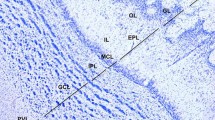Abstract
Catecholaminergic (CA-ergic) systems in the medulla of the Amur bitterling (Rhodeus sericeus) were studied using immunohistochemical labeling of tyrosine hydroxylase (ТН), the main enzyme of catecholamine synthesis. The peculiarities of localization of medullary neurons, morphology of the dendrites, and trajectories of the axon projections in the medulla of the Amur bitterling allow us to differentiate three groups of ТН-positive neurons, namely interfascicular cells, units related to the lobus vagus, and cells localized within the area postrema. Interfascicular medullary neurons form a longitudinal column of multipolar cells with broadly branching dendrites localized on both sides with respect to the midline. Neurons of the second group are smaller than interfascicular cells; their dendrites form branchings within the reticular formation and lobus vagus. On apical parts of the cells of the second group, there are branched processes directed toward the clearance of the cerebral ventricle. The third group consists of bipolar ТН-positive cells; their density of distribution is maximal near the area postrema. Terminal axon fields of medullary CA-ergic neurons in the Amur bitterling are connected with sensory systems of the medulla. In the periventricular region of this cerebral zone, we found phenotypically immature forms of the cells, highly immunopositive processes, and elements of radial glia expressing ТН. We hypothesize that, in fishes, dopamine functions as an inductor of development (morphogenetic factor) and is involved in postembryonal neurogenesis in matrix zones of the brain.
Similar content being viewed by others
References
K. Yamamoto and P. Vernier, “The evolution of dopamine systems in chordates,” Front. Neuroanat., 5, 1-21 (2011).
A. Björklund and S. B. Dunnett, “Dopamine neuron systems in the brain: an update,” Trends Neurosci., 30, 194-202 (2007).
P. K. Ма, “Catecholaminergic systems in the zebrafish. III. Organization and projection pattern of medullary dopaminergic and noradrenergic neurons,” J. Comp. Neurol., 381, 411-427 (1997).
J. G. Briñón, R. Arévalo, E. Weruaga, et al., “Tyrosine hydroxylase-like immunoreactivity in the brain of the teleost fish Tinca tinca,” Arch. Ital. Biol., 136, 17-44 (1998).
F. Adrio, R. Anadön, and I. Rodríguez-Moldes, “Distribution of tyrosine hydroxylase (TH) and dopamine beta-hydroxylase (DBH) immunoreactivity in the central nervous system of two chondrostean fishes (Acipenser baeri and Huso huso),” J. Comp. Neurol., 448, 280-297 (2002).
N. Flames and O. Hobert, “Gene regulatory logic of dopamine neuron differentiation,” Nature, 458, 885-889 (2009).
P. Vernier and M. F. Wullimann, “Evolution of the posterior tuberculum and preglomerular nuclear complex,” in: Encyclopedia of Neurosciences, Part 5, M. D. Binder, N. Hirokawa, and U. Windhorst (eds.), Springer-Verlag, Berlin (2009), pp. 1404-1413.
W. Smeets and A. Gonzalez, “Catecholamine systems in the brain of vertebrates: new perspectives through a comparative approach,” Brain Res. Rev., 33, 308-379 (2000).
S. Grilner, “Motor control systems of fish. Functional morphology of the brains of ray-finned fishes,” in: Encyclopedia of Fish Physiology: from Genome to Environment, Elsevier, Amsterdam (2011), pp. 56-66.
E. V. Puschina, “Evolutionary plasticity of catecholaminergic systems of the medulla of bony fishes,” in: Proceedings of II All-Russian Conference with International Participation “Modern Problems of Evolutionary Morphology of Animals” [in Russian] (Saint Petersburg, October 17-19, 2011), ZINRAN RAN, Saint Petersburg (2011), pp. 281-284.
Y. Morita and T. E. Finger, “Area postrema of the goldfish, Carassius auratus: ultrastructure, fiber connections and immunocytochemistry,” J. Comp. Neurol., 256, 104-116 (1987).
T. E. Finger, “The gustatory system in teleost fish,” in: Fish Neurobiology, Vol. 1, R. G. Northcutt and R. E. Davis (eds.), Univ. Michigan Press, Ann Arbor (1983), pp. 285-309.
C. A. McCormick, “Central lateral line mechanosensory pathways in bony fish,” in: The Mechanosensory Lateral Line. Neurobiology and Evolution, S. Coombs, P. Gorner, and H. Munz (eds.), Springer-Verlag, New York (1989), pp. 341-364.
R. Nieuwenhuys and E. Pouwels, “The brain stem of actinopterygian fishes,” in: Fish Neurobiology, Vol. 1, R. G. Northcutt and R. E. Davis (eds.), Univ. Michigan Press, Ann Arbor (1983), pp. 25-87.
Е. V. Pushchina, A. A. Varaksin, and D. K. Obukhov, “Cystathionine β-synthase in the CNS of masu salmon Oncorhynchus masou (Salmonidae) and carp Cyprinus carpio (Cyprinidae),” Neurochem. J., 5, 24-34 (2011).
B. Vigh, M. J. Manzano e Silva, C. L. Frank, et al., “The system of cerebrospinal fluid-contacting neurons. Its supposed role in the nonsynaptic signal transmission of the brain,” Histol. Histopathol., 19, 607-628 (2004).
B. L. Roberts, G. E. Meredith, and S. Maslam, “Immunocytochemical analysis of the dopamine system in the brain and spinal cord of the European eel, Anguilla anguilla,” Anat. Embryol., 180, 401-412 (1989).
M. J. Manso, M. Becerra, P. Molist, et al., “Distribution and development of catecholaminergic neurons in the brain of the brown trout. A tyrosine hydroxylase immunohistochemical study,” J. Hirnforsch., 34, 239-260 (1993).
P. J. Hornby and D. T. Piekut, “Distribution of catecholamine-synthesizing enzymes in goldfish brains: presumptive dopamine and norepinephrine neuronal organization,” Brain, Behav., Evol., 35, 49-64 (1990).
Y. Morita and T. E. Finger, “Topographic representation of the sensory and motor roots of the vagus nerve in the medulla of goldfish, Carassius auratus,” J. Comp. Neurol., 264, 231-249 (1987).
G. K. Zupanc, “Towards brain repair: Insights from teleost fish,” Sem. Cell Dev. Biol., 20, 683-690 (2009).
M. Kapsimali, B. Vidal, A. Gonzalez, et al., “Distribution of the mRNA encoding the four dopamine D1, receptor subtypes in the brain of the european eel (Anguilla anguitta): comparative approach to the function of D1, receptors in vertebrates,” J. Comp. Neurol., 419, 320-343 (2000).
Author information
Authors and Affiliations
Corresponding author
Rights and permissions
About this article
Cite this article
Puschina, E.V., Obukhov, D.K. Catecholaminergic System of the Medulla Oblongata of the Amur Bitterling (Bony Fishes, Family Cyprinidae). Neurophysiology 44, 279–291 (2012). https://doi.org/10.1007/s11062-012-9298-5
Received:
Published:
Issue Date:
DOI: https://doi.org/10.1007/s11062-012-9298-5




